Successful boating means keeping copious amounts of water out of certain areas and judiciously bringing it into others. Watertight seals and cleverly scuppered decks keep water out. Pumps complete the tango by bringing it in, say to fill a livewell or to wash a sandy or fish-bloody deck.
Choosing pumps for these jobs means balancing the limits of onboard power, livewell capacity and the space available for installation.
Washdown pumps have pressure switches that shut them down when there’s no demand for water. We tested two top brands, both offering kits that include a sea strainer to protect the pump.
Kits like our Johnson 5.2 that include hardware, hoses and quick-disconnect fittings speed installation. Even the sea strainer snapped in place, and the kit featured a fused switch panel that can be mounted near the pump’s outlet for convenience. The only thing we didn’t find in the kit is a bulkhead-mounted spigot, which will be needed to bring water to the cockpit.
How We Tested
Livewell pumps were mounted on a floating panel in a 25-gallon aquarium to maintain constant ideal contact with water.
Washdown pumps were set on the bench near the receiving tanks, and intake hoses were dropped into the reservoir tank.
Amperage draw was measured using a multimeter while the pump was under load with 20 inches of head.
Voltage applied was 12.5 volts. Some pumps are capable of running on 24 volts, but that voltage was not tested.
Average head of 30 inches was determined by measuring and averaging the increasing vertical distance from the reservoir water level to the receiving tanks — five-gallon buckets.
Pricing is the lowest acquired value located during our research and testing prior to publication, and could be subject to change.
Pumps for Under-40-Gallon Livewell
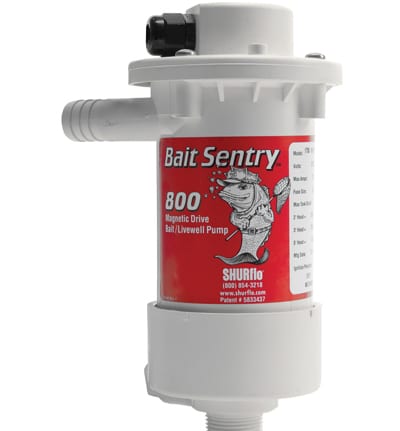
Shurflo
Bait Sentry 800/No. 1700-010-0
Special Features: Bait Sentry’s magnetic drive allows the impeller to stop turning when debris is ingested, while the powerful magnetic “clutch” allows the motor to spin harmlessly.
Special Hardware Included: The 3/4-inch threaded intake is ready to mate with a seacock.
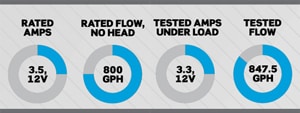
Materials Not Included: Sea strainer, Teflon plumbing tape, sealant and through-hull with seacock.
Performance Report: On my boat it lasted five years — far longer than for many pumps. It pushed 28 percent more water at a 30-inch head than its rated flow.
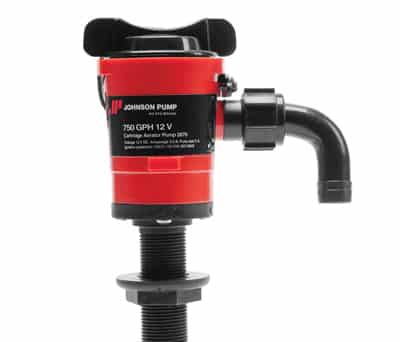
Johnson
Cartridge Aerator 750/No. 2870
Special Features: Removable motor cartridge design makes emergency repairs or replacement easy.
Special Hardware Included: The 3/4-inch threaded intake pipe and included nut may be used to form its own through-hull fitting, according to Johnson. Straight and elbow tailpieces add options.
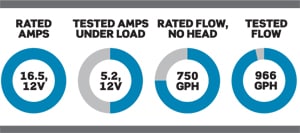
Materials Not Included: Sealant, gaskets and sea strainer are required to complete the installation. Consider using a seacock.
Performance Report: Our pump exceeded its no-head flow rating of 750 gph by 29 percent. The cartridge was among the easiest to replace thanks to “wing nut” ears on the cartridge and a simple locking device on the pump body.
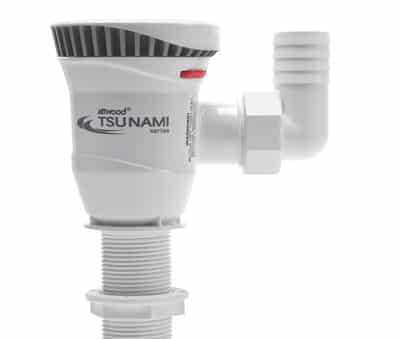
Attwood
Tsunami T800/Nos. 4608/4650/4670
Special Features: A replaceable motor cartridge eases change-outs should the pump fail. The integrated through-hull intake eases installation in cramped bilges.
Special Hardware Included: The threaded outflow port receives either a straight or elbow tailpiece, included.
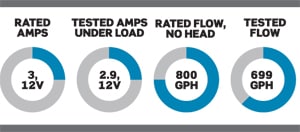
Materials Not Included: Sealant, required for through-hull mounting, or Teflon thread tape. Sea strainer is not included, nor is a through-hull or seacock, should the installation allow for it.
Performance Report: Turning the threaded cartridge counterclockwise releases the locking mechanism, allowing the cartridge to unscrew easily. The Tsunami 800 gave good flow, drawing a scant 2.9 amps — ideal for single batteries.
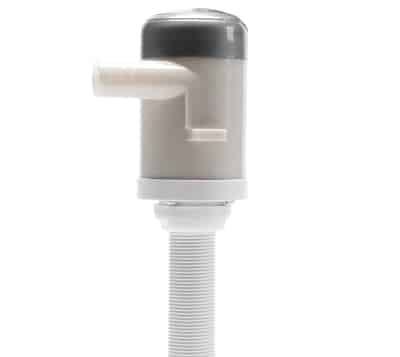
SeaSense
800
Special Features: This compact pump will fit easily in any small bilge area.
Special Hardware Included: The 800 ships with a straight through-hull installed and an extra 90-degree base for transom installations.
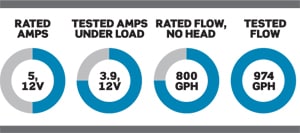
Materials Not Included: The pump includes a simple strainer to stop damaging debris from destroying it, but we’d still recommend a sea strainer. Consider using a seacock.
Performance Report: This compact R2D2-shape pump surprised us by exceeding its no-head flow rating by 22 percent. Its 5⁄8-inch spur has ample room for double clamping.
Pumps for Over-35-Gallon Livewells
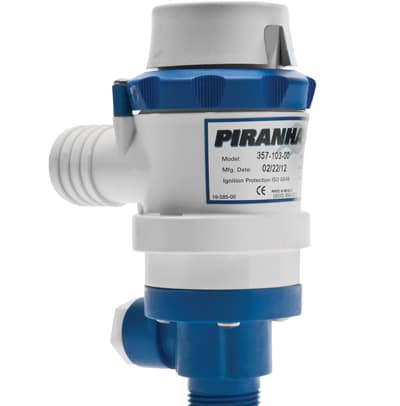
Piranha
1100/No. 357-103
Special Features: Complete with a separate outlet for a 3/4-inch-thread washdown fitting, this pump precludes the need for a second washdown through-hull. It is also equipped with a removable motor cartridge.
Special Hardware Included: Its short-threaded intake is designed for through-hull installation using a seacock.
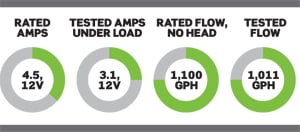
Materials Not Included: Teflon thread tape, wiring connectors, hose clamps, seacock and sea strainer.
Performance Report: It drew a thrifty 3.1 amps while delivering an ample flow rate of 1,011 gph. Easy removal of the well-knurled cartridge is facilitated by a topside locking screw and an oval base for easy gripping.
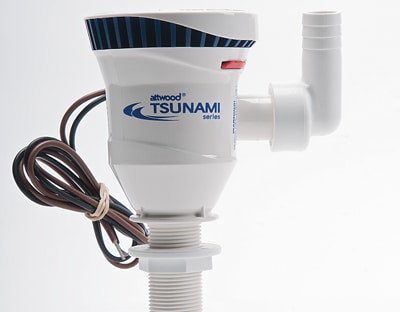
Attwood
Tsunami T1200/Nos. 4612/4660
Special Features: Like the T800, this pump includes a removable cartridge and is built with a large base flange to facilitate sealing the pump should it be mounted through the hull or through the livewell base. Sporting the same compact dimensions of the T800, it boasts a 33 percent more powerful motor.
Special Hardware Included: Threaded straight and elbow tailpieces with 3/4-inch fittings are included.
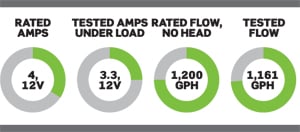
Materials Not Included: Teflon thread tape or sealant, hose clamps, wire connectors and sea strainer. Consider a seacock.
Performance Report: It lost just 3 percent of its rated flow at 30 inches and ran on a thrifty 3.3 amps.
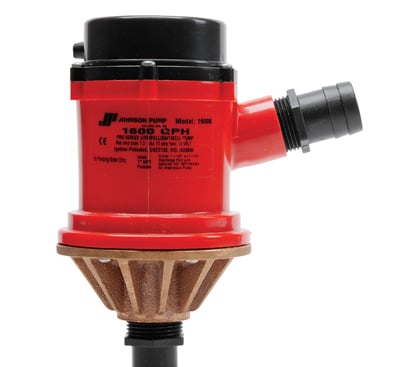
Johnson
1600 Pro Series/No. 16004B
Special Features: Capable of running on 12 and 24 volts, the pump is the only one in our test with a bronze bottom, making it ideally suited for seaworthy installations mated to a seacock.
Special Hardware Included: It comes with a single 3/4-inch-inside-diameter (ID) tailpiece (Johnson prefers the term spur) angled upward and threaded into the pump body plus a second port for a washdown tailpiece.
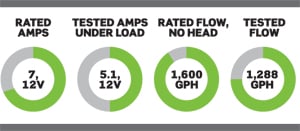
Materials Not Included: Teflon thread tape, wire connectors, hose clamps, sea strainer and seacock.
Performance Report: We tested this pump at 12 volts. It drew 5.1 amps and produced 1,288 gph of flow at 30 inches of head, an impressive accomplishment.
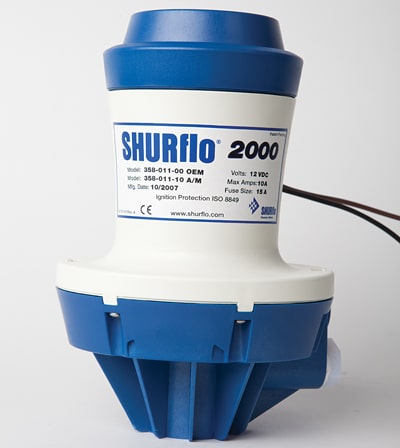
Shurflo
2000/No. 358-011-00 A/M
Special Features: A second 5⁄8-inch threaded port facilitates a second water pump, such as a washdown pump.
Special Hardware Included: The hose tailpiece is molded into the pump, and a second threaded port allows installation of a washdown hose.
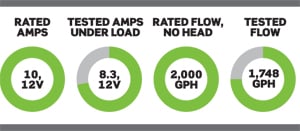
Materials Not Included: Teflon thread tape for installation on existing through-hull, hose clamps and wire connectors. Consider a seacock.
Performance Report: The 2000 pumped so hard I dropped the outflow hose and had to restart the test. Its powerful motor required 8.3 amps to deliver the water and is best suited for vessels with banks of two or more batteries.
Washdown Pumps
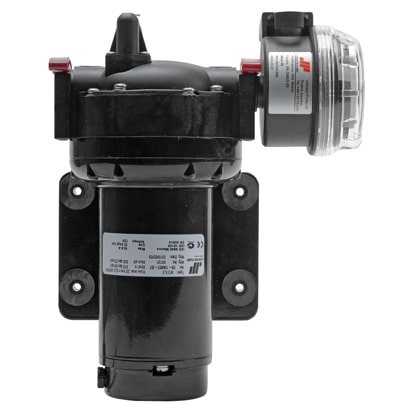
Johnson
Aqua Jet WPS 5.2 WD/No. 10-13407-07
Special Features: Pump-only package includes detachable tailpiece connectors for 3/4-inch-ID hose.
Special Hardware Included: Our test model included the installation kit with washdown hose, quick connectors for nozzles plus a fused on/off switch for convenient mounting.
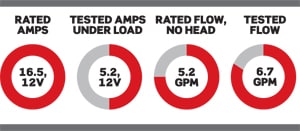
Materials Not Included: Through-hull fitting, clamps, mounting fasteners and cockpit spigot. Consider a seacock.
Performance Report: The 5.2 WD tested 28 percent above its pay grade, gushing 6.7 gpm at an average head of 30 inches. The modular snap-fittings and water strainer ease installation. Tailpieces are plenty long for double clamping, ensuring a no-leak fit and reliable operation.
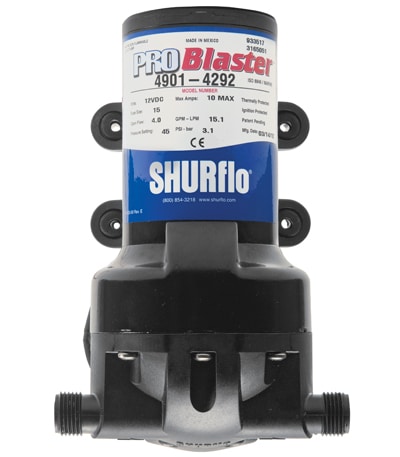
Shurflo
ProBlaster/No. 4901-4292
Special Features: Specs indicate the pump is ignition-protected, meaning it’s safe to mount within the engine compartment or bilge.
Special Hardware Included: No hardware was included with our test pump.
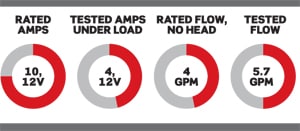
Materials Not Included: Through-hull fitting, cockpit spigot, inlet and outlet fittings and sea strainer are not included. Consider a seacock.
Performance Report: The ProBlaster pumped 42 percent more water through an unrestricted nozzle at the test head of 30 inches, exceeding its advertised flow rate. We could not get an airtight seal between the intake hose and intake port, but it didn’t prevent the pump from blasting out the above water-flow specs.
Nine Tips for Safe and Effective Pump Installation
1. Though several of these livewell pumps are designed for direct through-hull installation, the American Boat and Yacht Council recommends the use of seacocks and through-hulls for added safety should a hose or fitting break.
2. Use Teflon tape on threaded fittings and double clamps on hose connections to minimize hidden leaks.
3. To prevent corrosion, connect pump wires with heat-shrink butt connectors or waterproof Deutsch connectors.
4. Pre-installing Deutsch connectors on a spare pump cartridge makes for even easier emergency repairs.
5. Install any pump on an appropriately weighted switch with a circuit breaker to protect the wiring.
6. To protect the pump, also install a fuse of the appropriate size in the positive terminal lead to the pump nearest to the switch or device.
7. Use an adhesive sealant, like 3M 5200, on all through-hull fittings. Allow the sealant to cure overnight before tightening the nut the last one-quarter to one-half turn.
8. Route intake hoses lower than the pump to facilitate priming; mount non-self-priming pumps below the waterline.
9. Install switches on the helm, when possible, to minimize the likelihood they will be unnoticed and left energized.
Seacock or No Seacock?
During testing, we discovered a disconnect between marine industry practices when mounting pumps and ABYC standards that promote, absolutely, the use of a through-hull fitting and seacock to shut off the water, should the pump system rupture. We endorse the use of a through-hull and seacock because they offer better reliability and safety.
However, pumps with capacities of less than 1,000 gph are commonly molded with a plastic, threaded through-hull fitting and are sealed to the hull with a nut, gaskets and sealant on the outboard side. This practice is common in top-shelf bass and bay boats for a couple of reasons. First, it’s not always easy to mount the pump, as required, below the static water line when stacked on a through-hull fitting. Second, in boats where these small-capacity pumps are used, they are mounted in tiny compartments where a through-hull’s greatest enemy — an errantly placed foot or elbow — is prohibited anyway. So, we’ll nod at the practice in those circumstances.
And, we’ll reinforce one more tip all captains worth their salt should already know: Carry along a variety of cone-shape, softwood pegs, or bungs, to tap into a burst hose or fitting should a through-hull break. I have pals in Alaska who carry wax toilet ring seals to mold into such holes as well.








